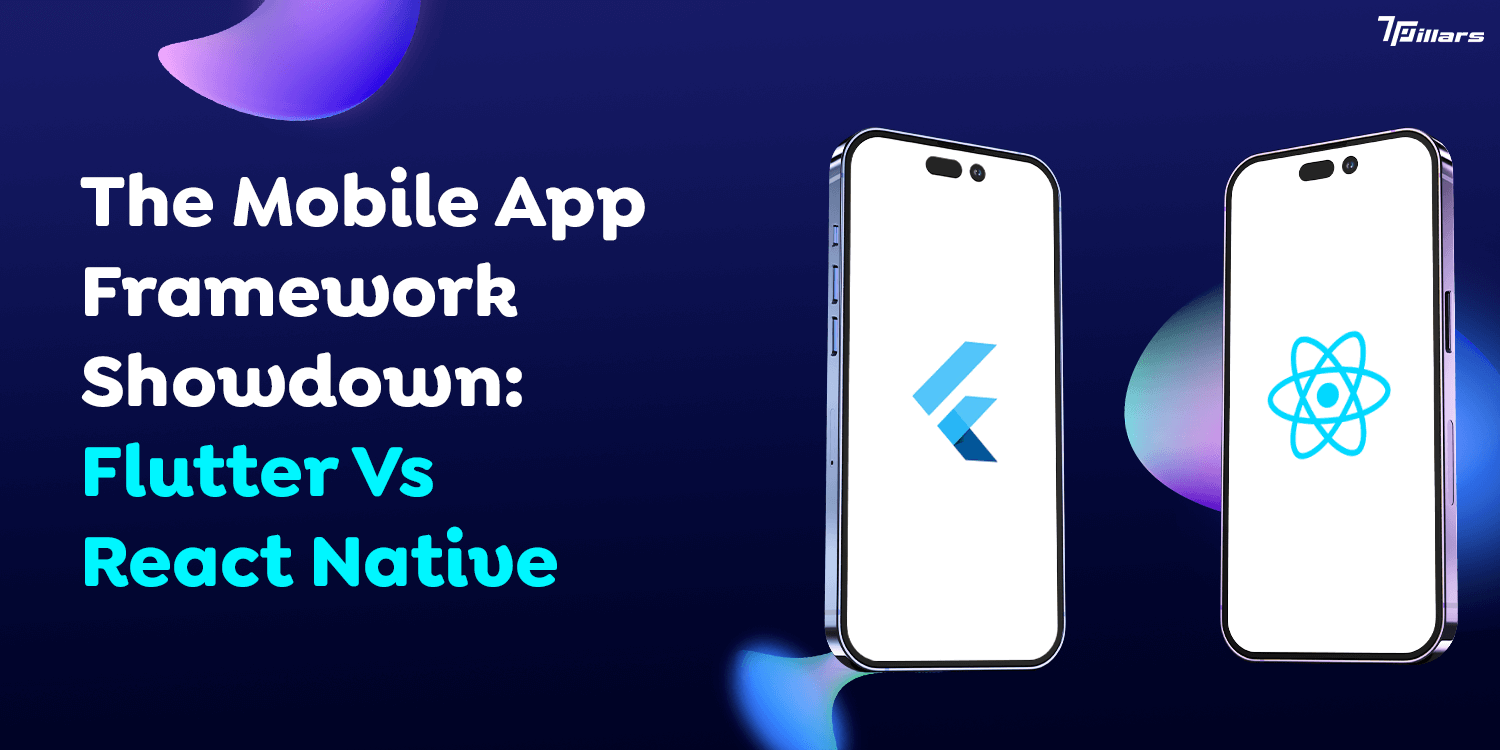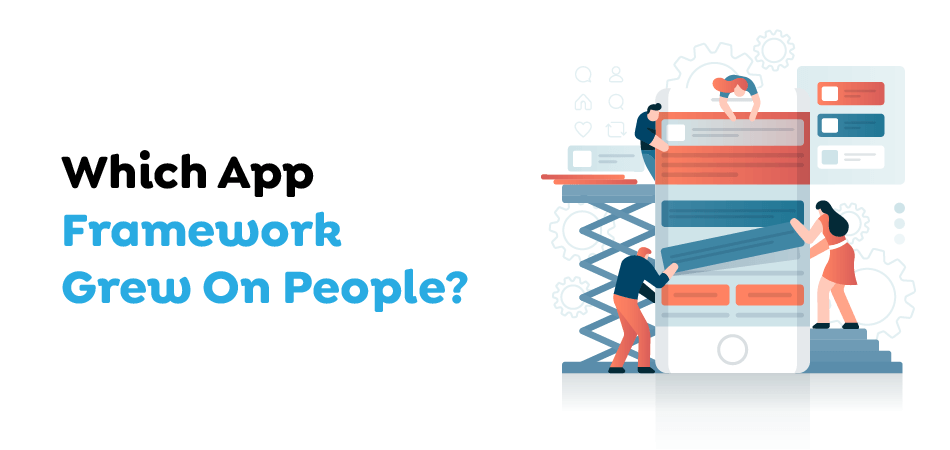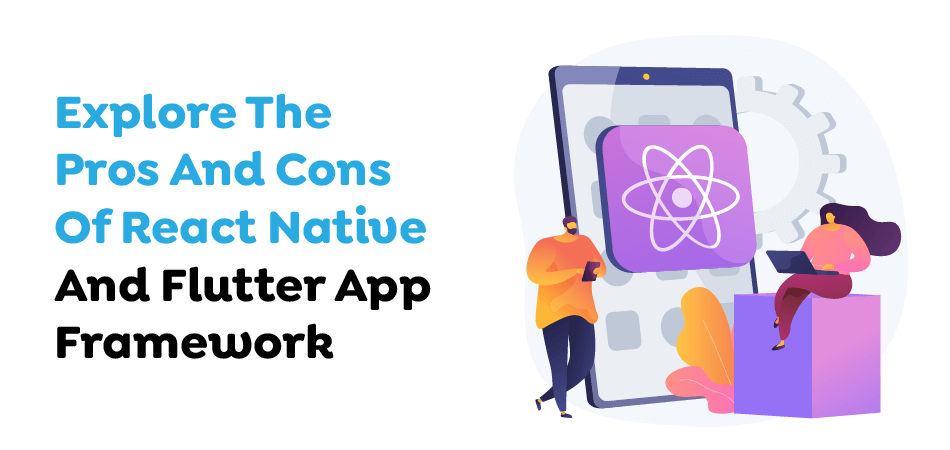29 Jul 2024
The Mobile App Framework Showdown: Flutter Vs React Native
Shaun Bell

Fast-changing technological realm brought many great inventions with it, such as mobile apps, and changed communication, work, and access to information, modifying several facets of daily life and corporate operations in the process. Over time, mobile apps became very famous because they make most tasks effortless for users to accomplish from the comfort of their homes, be it shopping or banking.
With this level of neck-to-neck competition, app development markets are a hot place, with everyone striving to produce cutting-edge and approachable applications. Through their stiff competition, designers and engineers keep expanding on functionality and design—providing high-calibre state-of-the-art solutions that eventually reach consumers.
Every other day, a new app reaches the markets for the end-users delight and experimentation, offering unique features and enhanced functionality in service of diversified needs and preferences, enriching the digital space and changing how we interact with technology in many ways. With fast speed, the frameworks React Native and Flutter change constantly, bringing new features to satisfy the ever-growing user and developer needs.
Every release of these frameworks brings more ease of use, new features, and improved performance; therefore, a developer shall always keep up-to-date with the latest trends and industry best practices. Imagine now that you are sitting at the helm of a very ground-breaking mobile app idea, and you can take over the market; in that context, choosing a proper framework to bring it forward would be the next equally important step.
In this case, enter the two titans of mobile app development: Flutter and React Native. Both promise a seamless and cross-platform experience, but which one aligns with your project’s needs? It is on the verge of deciding that we will delve into the key considerations which will lead you to the correct framework for the success of an application.
Harnessing the Power of Mobile App Frameworks for Business Success
If any business has to reach the pinnacle, selecting the appropriate app development framework for the application and channelling resources toward continuous learning and adjustment to harness these technological breakthroughs. Mobile app development has a promising future.
Whichever you choose between React Native and Flutter, knowing what can be gained from either will make it easy to select the accurate framework for your apps and help them shine amidst all the noise. Growth Of Mobile Apps In The Market
The proliferation of mobile applications in Australia has changed many industries and improved the lives of millions.
In the last ten years, Australia has been booming with innovative application developments that are envisioned due to the robust technological ecosystem. From banking and health to entertainment, Australians now rely on mobile apps for all purposes.
New and established businesses create mobile solutions to meet the growing need for efficiency and convenience. This has been driven even further by the country’s high smartphone density and people who are very technology savvy, which provides, unlike some other countries such as its neighbour, New Zealand, a positive environment for mobile app creation.

Growth Of Flutter And React-Native Apps In Australia-
Flutter and React Native application development have gained ground in Australia.
Recently, it has been reported that Flutter has attracted a rapidly increasing market share due to its fast development cycle and impressive UIs. However, React Native remains one of the tough competitors due to its mature ecosystem and broad adoption.
According to the surveys, Flutter is now preferred by roughly 30% of Australian developers for new projects, while React Native dominates with some 50% of the market. Both invest heavy energy into the App development landscape in Australia, focusing on Innovation and Efficiency.
How Can Developers Develop An App That Is Cost Effective Without Compromising With Quality?
By applying a few clever strategies, developers can deliver cheap apps without compromising quality. Choosing a framework is not a one-size-fits-all situation.
What works for one business or enterprise doesn’t work for another. It all comes down to what works for you and what the specific application requires.
First, by choosing a good development framework (say Flutter or React Native), one can make things easier and then reuse code on numerous platforms. It helps in saving time and reduces costs.
To prevent scope creep and needless costs in the early stages of creation, one should concentrate exclusively on the clearly defined scope and necessary features.
Agile development methodologies make provisions for iterative development, thus opening up possibilities of feedback and changes quite early without heavy financial implications.
As the fundamentals have been discussed, let us now discuss the advantages and disadvantages of opting for a React native framework over a Flutter framework.
What is the Flutter App Development Framework?
Released in May of 2017, Flutter is a brilliant open-source and portable user interface development kit used by app developers to develop brilliant cross-platform apps for their clients so that costs can be saved without compromising on the app quality.
The rendering engine and user interface language include Flutter, developed by Google. The rendering engine is part of any Flutter application after compilation – around 4 MB compressed – and the code for the user interface.
In contrast, other UI frameworks, such as native Android applications, which rely on the device-level Android SDK or HTML/JavaScript Web, applications distribute only the UI code itself and rely on a separate rendering engine.
This provides a simple way for developers to write natively compiled programs with just one code and launch them into the market. Flutter is open-source and free to use.
Flutter borrows its code from Dart, an object-oriented programming language. Several Dart features and syntax can make contemporary app development easier by letting programmers create beautiful, high-performance apps for many platforms from a single codebase.
It has robust typing and enormous library support, which complements the power of Flutter. Experts and app developers believe that in no time, Flutter will be the first choice for the development of apps by clients to work within a budget without compromising on quality.
Flutter is extremely popular among app developers and entrepreneurs who want to create an app which runs seamlessly on any platform due to its many benefits.

Key Features of Flutter App Development Framework–
Flutter is regarded as one of the top frameworks for creating mobile apps. Its exceptional qualities set it apart from the competition. Flutter is Google’s vision for a UI toolkit to build natively compiled applications across mobile, web, and desktop from a single codebase. This framework primarily uses Dart as its programming language, making it very strong at its core for developing high-performance apps.
1. Dart Programming Language–
Developed by Google and designed by Kasper Lund and Lars Bak, Dart is a programming language used to create versatile apps for different platforms with a single codebase, thus making it an ideal, budget-friendly language choice for developers. It is an object-oriented language that focuses on performance and productivity.
Some of the characteristics of Dart include a just-in-time compiler that runs at fast development cycles and an ahead-of-time compiler, which will compile into optimized native performance. It supports asynchronous programming using the Future and Stream classes, allowing it to handle real-time data and improve app responsiveness.
2. Widgets–
The user interface is a crucial component in drawing users to an application, and Flutter’s widget functionality facilitates the development of user-friendly, visually appealing interfaces that improve the user experience. Widget is an intrinsic feature of Flutter that helps build very flexible and dynamic user interfaces.
Widgets in Flutter are the primary elements that structure the app’s UI. This can range from simplistic buttons and text to complicated layouts and animations. They are arranged hierarchically, where every widget will work, representing a part of the interface. Flutter comes with an abundance of pre-built widgets, coupled with in-depth customization, making a designer’s job smooth in creating visually appealing and responsive designs.
3. Hot Reloading –
The Flutter hot reload is one of the most robust tools that accelerates development. It provides a developer instantly with what he’s changed without requiring a restart of the app, and loss of the app’s current state.
Every time changes occur in the app’s code, Hot Reload refreshes this user interface in real-time, not losing its state, which reduces the amount of time taken for every iteration. This feature boosts productivity and allows for quick experimentation, as a developer can test and iron out his design shortly.
4. Single Codebase –
With the release of Flutter, the dream of having your app work flawlessly across several platforms without requiring you to write separate programs is no longer a pipe dream. The single-codebase feature of Flutter empowers developers to develop just one set of code for iOS and Android applications.
By doing this, it makes the development process easy. Moreover, this enables them to use Dart with Flutter’s rich set of pre-designed widgets, creating a consistent user experience across platforms. It will provide both consistent performance and design at a time. Such an approach
Where Is Flutter Popular?
Due to the versatility and efficiency provided by Flutter in developing applications, it has become popular in various parts of the world. It finds high usage in the US, particularly in Silicon Valley and large cities where several start-ups and tech companies are located.
In India, Flutter is used because it provides speedy development with cost-effective services, thus finding apps in budding start-ups and well-established firms. Australia has also adopted it to a large extent, using Flutter’s cross-platform features to facilitate app creation. Moreover,
Flutter’s global community is rising across Europe and Southeast Asia, where the demand for high-performance, beautiful apps makes Flutter very valuable.
What Kind Of Apps Are Made Using Flutter?
It’s a versatile framework adopted to develop just about any app. It is mainly used in developing high-performance and aesthetic mobile apps such as e-commerce applications, social networking apps, and news readers. Flutter allows one to build complex applications, entailing rich animations and interactive user interfaces, such as fitness trackers or travel guides.
What Is A React-Native App Framework?
React Native, an open-source user interface framework developed by Facebook and released in 2015, makes it easy for developers to construct high-performing, cross-platform mobile applications using JavaScript and React. It allows for a smooth and effective development process for both iOS and Android.
It reuses the component-based architecture of React, which enables a developer to create a user interface with reusable components. Development is way easier because modifications done to any part automatically apply to the whole app. Besides being rich in libraries and tools, the ecosystem of React Native also provides easy ways to integrate native APIs and third-party services.
JavaScript is a widely used programming language used by the React Native framework. This framework shares the same design as Flutter, and the widget-like elements required to assemble apps are also shared by this framework.
Given its extended lifespan, React Native is a better-developed framework. It indicates that React Native has had more time to cultivate a development community.

Key Features Of A React-Native App Development Framework–
Ever since Facebook released it in 2015, React Native has been a game changer in the world of mobile app development. As an open-source framework, it aids developers in creating high-quality, cross-platform applications with JavaScript and React.
Among the most striking features of React Native is its near-native performance experience. Unlike traditional hybrid frameworks that use WebView components, React Native translates JavaScript code into native components, making for a much smoother and more responsive user experience.
1. Java Script And React –
React Native is a framework that utilizes JavaScript, a multi-purpose language primarily used for developing web applications for mobile app development. A developer can write code that would run on both iOS and Android from one codebase. React Native builds off a core JavaScript library called React.
It uses a component-based architecture, in which UI elements are built as self-contained components to enhance development efficiency and ease of maintenance. React Native serves as a link between native mobile app development and the web. This functionality enables a seamless and responsive user experience by leveraging native capabilities for performance and functionality.
2. Reusable Components –
Reusable components are core features of React Native that improve development efficiency. Components are the small, independent, modular portions of code that define part of the user interface, such as buttons, input fields, or even entire screens. This encapsulation of UI elements and their logic within reusable components helps developers build and manage apps effectively.
It means that each element may be reused as many times as necessary throughout different app areas. This minimizes duplicity, hence ensuring consistency. Additionally, because updates to one component are automatically reflected in all instances where that component is utilized, the modular approach greatly simplifies maintaining or updating the code.
3. Live Reloading-
Live reloading in React Native means that changes will show in real time as one is coding. With every change a developer makes in the code, it reloads the app on its own and updates the changes without any rebuild or restart. This feature speeds up work by giving immediate feedback, allowing for quick iteration and debugging.
It helps smooth workflow processing since a developer can instantly test a new feature or fix an issue while the app runs. Live reloading boosts your productivity and gives assurance that the changes are going to show up correctly both in your app’s UI and functionality.
4. Single Codebase-
One of the best features of React Native is that it supports a single code base. This allows developers to create one set of code that can be applied to both iOS and Android. Using JavaScript and React, apps can be built to share most of their code among different operating systems.
It helps shorten development time and effort because there is no requirement to code for any particular platform separately. It will also help in the uniform behaviour and appearance of the application since everything can be reused. In this case, a single code base makes maintenance and updates effortless to handle, thus making it easier to manage and scale over time.
Where Is React Native App Framework Popular?
React Native has gained worldwide popularity and usage in the United States, India, China, and the United Kingdom. Major technology companies and even start-ups in the United States use React Native to help drive their efficiency and performance. India is thriving in the tech world, with many developers using React Native to create cost-effective cross-platform apps. The booming tech scene in China uses the framework since it is flexible.
React Native is most preferred in Brazil and the UK because it is easy to develop on several platforms quickly. Thus, entrepreneurs can quite effortlessly get into different markets with varied products. Generally speaking, React Native has massive popularity within many countries because of its strength.
What Kind Of Apps Can Be Built Using React-Native Framework?
It can be used to develop various types of mobile applications, from social media and e-commerce to messaging services and productivity tools. That’s also possible while making apps with complex UIs and interactions including streaming services, fitness tracking, and even travel applications. React Native supports native components and performance optimizations; it would work for apps requiring high responsiveness and a smooth user experience.

Flutter vs. React Native: Pros And Cons
Pros Of Using Flutter For Your App-
1. Reduced Testing Time –
Flutter reduces test time due to the incorporated hot reload, which helps developers view changes instantly without an app restart. This functionality accelerates development and testing speed due to fast iteration and real-time debugging. Moreover, Flutter’s single codebase for iOS and Android significantly reduces the requirement for multiple tests, thus reducing the time consumed. In addition to full-featured widgets and a robust set of out-of-the-box components, Flutter allows teams to focus on the user experience refinement and not deep into cross-platform checks by reducing the need for extensive custom testing.
2. Faster Applications –
It enhances the performance of apps by compiling them into native ARM code. It also comes with faster execution and smooth animations. No frameworks would have placed a bridge between the app and its native code, just like Flutter did using the Skia engine, which empowers high-performance direct rendering to screen support.
It reduces overhead and brings the very best responsiveness possible. Moreover, its widget-based architecture helps Flutter provide an extremely high level of control over every pixel, contributing to an excellent UX.
3. Aesthetically Pleasing-
Flutter takes the lead in app development that showcases beautiful designs because of its rich set of customizable widgets. These widgets are based on Material Design and Cupertino standards, which allow designers to create visually consistent and appealing user interfaces on Android and iOS.
Flutter’s robust Skia graphic engine will ensure smoothness in animation and transitions for a smooth user experience. Its flexible design system makes this framework also support complex UI design and intricate visual effects.
4. Better Support System-
It is strongly backed by extensive documentation, a robust developer community, and massive resources. Well-maintained official documentation covers everything from basics to advanced topics and helps developers at any level.
The vibrant community enhances the development process along with contributed plugins, packages, and fixes for frequent problems. Google itself, being Flutter’s creator, is developing the framework by updating and improving it on time to keep pace with industrial trends.
Moreover, support from Firebase in Flutter for backend support with analytics, authentication, and cloud storage is seamless. It enhances development, reduces troubleshooting time, and helps maintain high-quality applications with its large-scale support ecosystem.
Cons Of Using Flutter App Framework-
Even though there is an array of benefits to using the Flutter framework, there are some disadvantages like the need for more customization and native code integration, the bigger app sizes resulting from the integrated widgets and engine, the restricted availability of third-party libraries in comparison to more well-known frameworks; and possible problems with platform-specific features and upgrades.
1. A Limited Developer Base–
A primary downside of Flutter is that the developer’s community is comparatively smaller than React Native. This number is, however, a bit fair, as more and more developers are becoming interested in Flutter—61 per cent would now consider using Flutter. Another reason Flutter has a small community is because Dart, the programming language Flutter is based on, isn’t used or familiar to many, unlike JavaScript, which forms the backbone for React Native.
The development community of a smaller Flutter framework possesses a few challenges. With fewer developers, there are limited resources, tutorials, and third-party libraries, so finding solutions for positive problems becomes hard. This reduced talent pool might lead to extended recruitment periods and higher salaries for skilled Flutter developers.
2. Extensive codebase to maintain
An application developed using Flutter usually has a bigger codebase compared to one built with React Native. This is supposedly a reflection of the fact that Flutter provides a rich set of widgets and, with its custom rendering engine, contributes to an extensive code structure that can be hard to follow.
With React Native, a simpler interaction with native components may result in a smaller codebase, but this means that developers will need to create and manage more code to accomplish the same functionality.
It’s challenging to manage a large Flutter codebase, especially when working with smaller teams or on projects with little funding. Rich widgets and rich features produce complex code with equal conditions. Managing an extensive codebase takes increased time and effort in updates, debugging, and testing.
Pros Of React Native App Framework –
React Native changed the face of mobile app development with an addictive mix of efficiency and versatility. Having the power to create top-notch, near-native experiences on iOS and Android from one codebase gave React Native a massive boost—being the prime choice for any developer looking to smoothen their workflow.
Moreover, it has broad community support and a library of already-built components, enhancing framework appeal for rapid development and reducing time-to-market. In other words, it’s not just a fast development tool but also assures robust performance, making it an aggressive solution for mobile applications today.
1. Increased Development Autonomy
React Native offers better development independence because developers can deal with one codebase for both iOS and Android, which enhances the speed of development. In addition to a robust, large ecosystem, it has an active community from which one can leverage libraries and tools to speed up the implementation of features and fix bugs.
Another characteristic of React Native is hot reloading, which gives the ability to work with real-time updates in the development process for quicker iteration and debugging. This autonomy will make the development team less dependent on platform-specific expertise and faster in delivering cross-platform applications.
2. Significant, Lively Developer Group
The high dynamics of the developer community in React Native are very beneficial since they provide a collaborative atmosphere for problem solutions and the creation of innovations.
The active community contributes to massive shared knowledge via forums, open-source libraries, and frequent updates, thus accelerating development and troubleshooting. An active community also hosts extensive resources, tutorials, tools, and plugins, making this process much easier and boosting productivity.
It creates a support network that shall keep developers updated with new developments so their apps can leverage cutting-edge features and best practices. In other words, the dynamic community around React Native enhances the efficiency and innovation involved in mobile app development.
Cons Of Using React-Native App Framework –
Although React Native has become one of the most popular frameworks for cross-platform mobile apps with a single codebase, there are also cons to the framework. Besides the exciting UI and features, one may come up with a few challenges that would dent your development process.
1. Performance Issues –
One of the significant drawbacks to performance in React Native is its dependence on a bridge between JavaScript and native code. Such architecture may introduce latency, especially for complex applications that require high processing power or real-time interactions.
The bridge enables communication between JavaScript and native modules, though it would generally be slower than fully native apps. A reputable flutter app development company can help you build the app of your dreams by providing an exquisitely crafted, high-performing solution with cross-platform coherence and customized features that reflect your vision and objectives for your organization.
2. Limited Access To Native Features–
React Native makes cross-platform programming considerably effortless, but it does not provide access to many native features in many cases. While it has quite a good number of inbuilt components and APIs, there are chances that, by default, frameworks might not allow access to certain native-related functionalities.
It implies that developers might have to use third-party libraries to create unique native modules or bridges, which would add complexity and possibly instability. This limitation means that the development of advanced features or utilization of some specific hardware feature may be additive in effort and expertise, probably affecting the development time and raising the possibility of compatibility issues.
3. Dependency on Third-Party Libraries
The biggest drawback for React Native is its dependency on third-party libraries. While libraries are valuable and often save development time, they are risky. These libraries may or may not be supported, updated, or even compatible with the new versions of React Native or mobile platforms. The hassle is in maintaining such projects; the developers constantly update or replace libraries to ensure the application stays compatible and secure. Moreover, relying on third-party code is susceptible to unpredictability and bugs since libraries’ quality and reliability vary greatly.
Third-party libraries, though beneficial, thus require attentive management and vigilance. A reputable app development company can help you steer clear of these obstacles by ensuring that your code is well-tested, keeping it up to date, and offering professional advice on which libraries to use and how to incorporate them into your project.
4. Long-Term Maintenance–
The maintenance of React Native apps, in the long run, is challenging because of the high frequency of updates and constantly evolving dependencies. Since it, and its ecosystem in general, is quickly progressing, developers continuously alter their code to be compatible with new versions of React Native.
It will also entail updating libraries, fixing deprecated features, and checking for possible conflicts between different components. Changes in the base platforms, iOS and Android, may need long-term adjustments to execute and render uniformly.

How To Choose Between Flutter And React-Native App Framework For Your App?
1. Performance—
Flutter mostly performs better, as it directly compiles native code, which inherently eliminates most of the performance bottlenecks. With a custom rendering engine like Skia, Flutter produces fluent and high-performance graphics.
On the other side, React Native uses a bridge between JavaScript and native code. This can introduce latency in execution to some extent, especially for complex applications. On the other hand, React Native’s performance is often sufficient in many use cases.
2. Development Experience:
A large, mature ecosystem and third-party libraries at its disposal make development easier and faster in React Native. The one also uses JavaScript, which is very well-known by most developers.
In contrast, Flutter uses Dart, which, although less common, is designed for high-performance UI development. Flutter has a “hot reload” feature like React Native, where it can test and iterate quickly, thus improving the development experience.
3. UI/UX:
Due to the comprehensive set of pre-designed widgets and the capability to control every pixel on the screen, Flutter stands out in creating extremely individualized, eye-catching UIs. That may be an advantage if you need some unique and consistent look between platforms.
React Native relies on native components, which may help achieve platform-specific styles but could make it harder to care for both iOS and Android.
4. Community and Support:
Due to its broader and more established community, resources, tutorials, and third-party libraries are available. Although Flutter’s community is expanding quickly, it is still smaller than React Native’s. This may affect the resources and support systems available in the community.
5. Integration and Maintenance:
React Native integrates well into existing native codebases, with good support for integrating with third-party services. Flutter is still developing on these points but gets its way. Both require maintenance; still, the Flutter ecosystem develops more solid solutions.
A brilliant Flutter app development company can help you by integrating cutting-edge features with ease, maximizing efficiency, and guaranteeing seamless platform compatibility, eventually improving the general functioning and user experience of your app.
The decision between Flutter and React Native will ultimately come down to the particular requirements of your project, the level of experience on your development team, and your long-term maintenance schedule. A change in the right direction toward the framework that supports your app development objectives can be achieved by considering the elements.
Conclusion –
After all, this decision strongly depends on the unique needs and targets you plan to reach with your mobile app project. React Native, with its mature ecosystem and massive array of pre-built components, stays a sturdy and obvious choice for developers looking for a mature framework. Agile community support and integration with native components guarantee a smooth experience for those familiar with JavaScript and React.
Flutter is, on the other hand, impressive for general expressive UI capabilities in modern apps, paired with the consistency of performance across all platforms, which is perfect for new projects. A highly beneficial feature-driven programming tool for app development with rich interfaces, Flutter employs the unique widget-based architecture alongside the Dart programming language to allow a more customized and cohesive user experience.
7 Pillars, a flutter app development company can help you build aesthetically attractive, high-performing apps with accelerated development times, unified cross-platform user experiences, and a smooth user interface that enhances your brand appeal.
7 Pillars, a leading app development company can help our client by providing state-of-the-art, tailored mobile applications that offer flawless user experiences, enhanced performance, and cutting-edge features, ensuring they meet their objectives and differentiate themselves in a crowded market.
Factors such as the speed of development, app performance, and long-term maintenance will be just as influential in making the final decision. React Native is by far the most well-known for its exceptional clarity and lack of surprises, whilst Flutter may provide a slightly novel way to better appeal to customers seeking exceptional design and seamless product performance.
Our team at 7 Pillars, a brilliant app development company is excellent at developing user-focused, highly scalable mobile apps that use the newest technology. We guarantee outstanding performance, simple design, and a smooth experience that is customized to your particular business requirements.
In the end, both frameworks have strengths and potential downsides. Therefore, align your choice with the requirements at hand for your project and the expertise of your team to leverage the strengths of Flutter or React Native when building a high-quality mobile app that will serve your purpose and delight your users. So if you are looking into developing a react native or flutter app framework, get in touch with our team today at 7 Pillars, a leading app development company in Australia.








